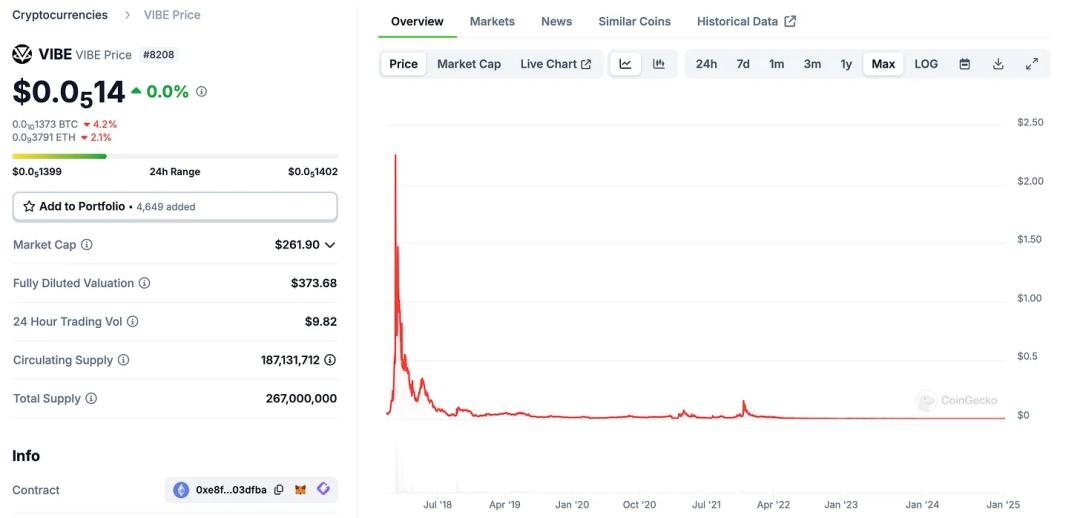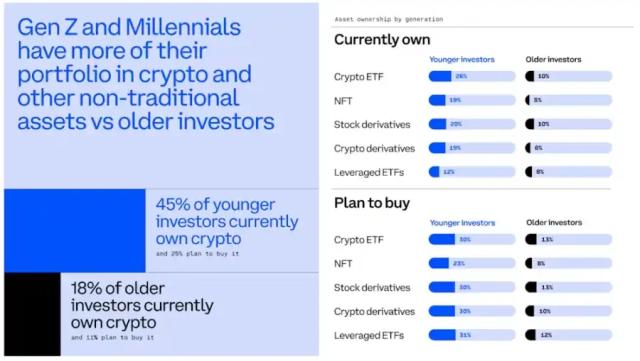Author | BowTied Bull
Compiled | Bai Hua Blockchain
With the arrival of 2025, in the transition between the old and the new, we will all summarize the past and look to the future according to habit.
Looking back on the past of the crypto industry, we can find an interesting phenomenon, that is, there will be a "Altcoin season" every four years, during which you will find that everything in the industry is rising, and you may hear that your drunken uncle also bought some animal expression packs and made a lot of money, and even completed the operation in a drunken state.
By 2025, the real Altcoin season can be said to have not yet fully arrived. Although no one can predict how crazy this Altcoin season will be, here I want to remind everyone that the trend of Altcoins is generally out of control and may also end suddenly. Once the crash, the decline may not only be -99.99%, but may even be a complete collapse.
However, before that, everyone is immersed in the atmosphere of various prosperity and entertainment. So, let's review the past Altcoin seasons and see how they have developed, and see if we can learn some valuable lessons from them.
01, 2012-2013 Altcoin Season: Early Enthusiastic Investors, Market Cap Reached $15 Billion
We know that the blindly following people are likely to appear again in the market. This situation occurred in 2013, and the trend became very interesting.

During the "Altcoin season" in 2013, Bitcoin was still in the initial development stage, with a total market value of only about $1 billion, and a whale transaction was only about $100,000. At that time, the CEX Mt. Gox was still in operation, and the investors were mostly those who often appeared in the "Magic: The Gathering" trading card activities (which was also the background for the Mt. Gox incident).
At that time, people proposed the idea of improving the speed of Bitcoin transactions, believing that reducing the block time could accelerate transactions, which was seen as a groundbreaking innovation at the time.
Litecoin: It still exists today, and the whole idea (proposed by Charlie Lee) was to shorten the block time from 10 minutes of Bitcoin to 2.5 minutes.
The price of Litecoin rose from about $0.10 to $48, an increase of about 47,900%, and it rose sharply again in 2017, then Charlie Lee sold all his holdings at the top, and claimed that "Bitcoin network is fine without him" (everyone knows what it means when the founder sells 100% of his holdings).
Namecoin: This is a Bitcoin fork coin aimed at creating a decentralized domain name network (similar to the concept of ENS expanding through ".eth"). Its price once soared to about $13, but soon fell into a trough. From the lowest point to the highest point, its price rose about 30 times. In fact, it still exists today, with a current trading price close to $1.

Peercoin (PPC): This is one of the earliest Proof-of-Stake Tokens (this mechanism is now used to ensure the security of ETH), and it experienced two major rallies. The first was in 2013, and the other was in 2017 when the ETH ICO craze erupted. Its price once soared to about $7, a 60-70 times increase. Of course, it did not gain mainstream adoption and eventually fell to $0.42. (However, the conclusion for the next one is that, except for pure Ponzi schemes like Bitconnect or LUNA, nothing else in the current market will really go to zero.)
Frenzy: Bitcoin eventually reached $1,200, and these cryptocurrencies surged due to the increase in people's interest in crypto. Any project that posted on BitcoinTalk could quickly rise just by speculation. The closest thing to this situation today is probably a Memecoin promoted by a celebrity or a Memecoin named after a celebrity.
Mt. Gox Collapse: When Mt. Gox collapsed, the party was over. This collapse was due to a major hacking attack, which caused the price of Bitcoin to plummet, probably by 85-90% (depending on how you view the bottom), while the Altcoins plunged more than 99%.
02, 2017 Altcoin Season: ICO Craze and the Rise of Ethereum, Market Cap Reached $800 Billion
Subsequently, during the bear market, many interesting events occurred. Ethereum was born as a smart contract platform, with the goal of creating programmable money. This was a true innovation, as it not only allowed people to transfer Tokens, but also to create smart contracts, completely changing the entire game.
Like many things in the crypto space, Ethereum also came with some common risks. Ethereum's DAO (Decentralized Autonomous Organization) was hacked, losing over $100 million, ultimately leading to a blockchain fork, forming ETH and ETC. To this day, some still believe the fork decision at the time was wrong, but we're not going to discuss that here, just a simple review of this history.
Around 2016, people realized that new Tokens could be issued on the Ethereum blockchain, which gave rise to the Initial Coin Offering (ICO). In ICOs, project teams directly sold Tokens to investors. In 2017, the ICO craze officially erupted, and many scam projects you can think of emerged at that time.
Ethereum (ETH): Because these Tokens required ETH to be issued, it drove the rapid rise of ETH price, from about $8 to $1,400 in January 2018, which was almost unimaginable returns at the time. Currently, the trading price of ETH is around $3,650.
XRP: XRP is still seen as the "bank coin", with the theory that Ripple will replace SWIFT (the international fund settlement system) overnight and become the de facto financial standard. Although Ripple is centralized (but most people don't mind), it still attracted hundreds of millions in funding. The price of XRP soared from about $0.01 to $3.80, and the current trading price is $2.41.
Interestingly, the XRP investor community is still mainly retail investors. In the recent wave of rallies, you can see a similar phenomenon - XRP is dominating on TikTok, attracting a lot of discussion, and some even propose "what if its market cap reaches the same level as Bitcoin?" This discussion about a "40 billion dollar market cap" is somewhat absurd.
Litecoin: As mentioned earlier, Litecoin rose again, with its price soaring to $360. Although Charlie Lee sold all his Litecoin, in 2021 it still surged again to $384!
EOS: EOS raised $4 billion through ICO, claiming to be the "Ethereum killer". Its price once soared to $22, but has not been able to set a new high since then.
NEO: Another project that claimed to be the "Ethereum killer", called the "Ethereum of China", NEO's price rose from $0.20 to $200, achieving a 1000x return.
Bitcoin Cash: Roger Ver was a well-known figure in the Bitcoin circle, who participated in the big block debate and supported Bitcoin Cash. At block 478,559 in August 2017, users holding 1 Bitcoin would receive 1 Bitcoin Cash. Due to Roger Ver's support, the price of Bitcoin Cash once soared to around $3,800, but then gradually faded from people's view.
Other Ethereum Killers: During this period, some other Tokens were also promoted as "Ethereum killers" (such as ADA, Tron, etc.). If a Token had a "whitepaper", it seemed to be able to drive its price to achieve 10x, 100x surges. Other Tokens, such as Filecoin and Tezos, also went online during this period.
Yield Ponzi Schemes: If you think BlockFi, LUNA, Celsius and Voyager are the first yield Ponzi schemes, you're wrong! In fact, the first large-scale yield Ponzi scheme was Bitconnect, which caused many people to lose millions of dollars.

Regulatory intervention: Just like the 2021 cycle, the intervention of regulatory authorities and the collapse of Ponzi schemes have once again devastated the entire industry. The U.S. Securities and Exchange Commission (SEC) began to investigate projects like EOS, and the market experienced a solid 85% correction, with the Bitcoin price falling to around $3,500 by March 2020.
During that period, most Tokens were just scams, so the Altcoin market experienced an almost -99.999999% crash. At that time, if your Token appeared in a Super Bowl ad, its price could have instantly quintupled. VIBE was a typical example.
VIBE's price soared from $0.04 to over $2, but its total market cap eventually plummeted to just $262.

03. 2021 Altcoin Season: DeFi, NFT and Memecoin, with a peak market cap of $3 trillion
In 2021, due to well-known reasons, everyone was working from home, staring at computers and phones with nothing to do. The U.S. government printed $10 trillion, and that was just the U.S. government's spending.
DeFi projects drove liquidity mining, NFTs made JPEG images mainstream (selling for millions of dollars), and Memecoins reached ridiculous valuations. Bitcoin broke through $69,000, ETH reached $4,800, and the total cryptocurrency market cap surpassed $3 trillion in November 2021.
Dogecoin: Initially just a joke, but with Elon Musk's interest in the coin, its price began to rise parabolic, becoming a hot topic on the Reddit platform. Today, it has almost become Elon's meme coin, representing the government efficiency department. The price soared from about $0.005 to $0.74, an increase of about 15,000%.
Solana: Touted as the next "Ethereum killer", it attracted a lot of attention with its fast transaction speed and low fees. This was mainly driven by SBF (now imprisoned). The price soared from $1 to around $260, an increase of 26,000%.
Shiba Inu: A meme coin mimicking Dogecoin, it created a large number of millionaires. Compared to its near-zero market cap, its increase reached 500,000%.
DeFi Tokens: Tokens like AAVE, UNI, SUSHI, and YFI saw gains of 10x to 50x, and the total value locked (TVL) in DeFi surpassed hundreds of billions of dollars. Today, the TVL of many DeFi projects is even higher than at that time!
NFTs:
CryptoPunks: Sold for millions of dollars, with the cheapest CryptoPunk price exceeding 100 ETH.
Bored Ape Yacht Club (BAYC): Became a cultural phenomenon, with the lowest price reaching an incredible level.
Airdrop Frenzy: For some project's old users, just owning a $100 .eth domain could get them a $40,000 Airdrop. You could even earn 2% returns in a day or a week by crossing a bridge (completing certain operations). Projects like BAYC also airdropped large amounts of other high-valued NFT series, with the total Airdrop amount reaching billions of dollars.
Even crazier... almost all Tokens were rising, with Tokens like SAFEMOON being praised by figures like Dave Portnoy. Celebrities like Snoop Dogg and Paris Hilton were endorsing various projects. Tom Brady and Stephen Curry were promoting cryptocurrency exchanges. Even the now-defunct FTX once spent money to purchase the naming rights of the Miami Heat NBA team.
Ponzi Schemes: A large number of Ponzi schemes emerged. Although some accused us of being involved in these scams, we actually did not participate. Fortunately, many people successfully avoided major losses. Investing in these products and entrusting your assets to others has never been a wise move.

Death Spiral: As liquidity began to dry up (the funding previously provided for these projects was no longer available), we saw the collapse of the aforementioned Ponzi schemes. Additionally, the FTX collapse due to the misappropriation of user funds, followed by the SEC stepping in again for regulation. The various large-scale scams and rug pulls ultimately led the crypto industry to enter a period of strict regulation in terms of access.
04. Key Lessons
1) Take profits in time: The market changes rapidly, and you may develop a sense of greed. If you find yourself saying "I wish I could buy 2x of a certain Token", then you should probably sell half your position and be content with the gains. It doesn't matter if you sell Bitcoin, Ethereum, or stablecoins, the key is to avoid greed.
2) Hype cycles repeat: Each Altcoin season has a narrative theme: Bitcoin forks, ICOs, DeFi, NFTs, or Memecoins. If you find a theme, it's best to stick with it, as the knowledge you accumulate in that field often quickly disappears when the cycle ends. Rather than jumping around, focus on a specific area and reap the ultimate victory.
3) Risk management is crucial: The returns can be very attractive, but everyone's situation is different. You are different from me, and I am different from my neighbor. Develop a plan that suits you and stick to it, don't keep adjusting your goals because someone with $100,000 says "1 million dollars is still not enough to retire".
4) Survivors will thrive: Altcoins come and go, but Bitcoin and Ethereum have dominated in every cycle. If a project has been around for so long, the risk of it going to zero is relatively low. If Solana can find real-world applications that surpass Pump.fun by 2025, it may also approach that level.
Have we learned anything from Ponzi schemes? Not really. From what we've seen, people still don't understand the concept of "Not Your Keys, Not Your Coins". You can buy crypto stocks or other crypto leveraged assets at brokerages, but you need to understand that if you hold these stocks or crypto ETFs, you don't actually own any cryptocurrencies. You'll never know how these companies or projects will handle the assets you've invested.
During bull markets, we are often criticized for not participating in the latest Memecoin hype. While these speculative activities may seem very hot at the moment, if you observe closely, you'll find that those who have stuck to their own strategies and remained calm are gradually accumulating.
In contrast, those speculators who only want to get rich quickly through "10x returns" may receive market attention in the short term, but their capital and strategies are far from comparable to those anonymous whales who have been steadily investing and accumulating wealth every month. These whales usually have a more solid financial foundation and a clearer long-term plan. Ultimately, the market's performance and data will prove what kind of strategy is the key to success.
Finally, wishing everyone good luck in 2025.





